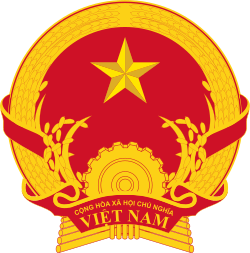Vietnam and the International Monetary Fund
Vietnam joined the International Monetary Fund (IMF) on September 21, 1956, under the policy of Article VIII.[1] Their quota contributes an estimated SDR of 1,153 millions and voting power of 0.24%.[2] As of August 2016, the current IMF Resident Representative to Vietnam is Jonathan Dunn.[3]
Following the events of the Vietnam War, most trade and financial relations between Vietnam and foreign entities was severely restricted. The Soviet Union remained one of the few nations with continued contact with the financial institutions in Vietnam. After the Vietnamese withdrawal from Cambodia in 1989, Japan was among the first to express a desire to resume financial aid relations with Vietnam. Japan and France endeavored to reestablish Vietnam's involvement in the IMF but were met with resistance from the United States who were seeking to use the restrictions to the pressure the nation to cooperate in establishing the whereabouts of missing US military service members.[4]
Informal contact between the IMF and Vietnam was reestablished in the later part of the 1980s. The US voted down most efforts to establish continued relations and financial assistance from the IMF to Vietnam until the early 1990s. A preliminary formal agreement for financial support was not reached until October 1993 and codified in a full agreement a year after that.[5]
So far they have taken about two ECF type loans, one on April 13, 2001, which estimated 290 SDR million, and the other on November 11, 1994, which had reached about 145 SDR million.[6]
In 1998, Vietnam was in slow recovery of its economy after the Southeast Asia Economic Crisis. As a member of ASEAN, their best solution was to heavily rely on loans from the IMF.[7] In 1999, IMF warned that the federal direct investment into Vietnam was too concentrated in the "import substituting and non-tradable" sectors like construction and telecommunication as opposed to investment in exportable goods and services.[8]
In 2001, Vietnam sent a letter of intent to the IMF to receive a loan to fund the Poverty Reductions and Growth Funds arrangement.[9] In order to create a greater macroeconomic stability for Vietnam they would rely on the monetary policy while under shock scenarios as it has proven to lift off interest rates.[10] According to IMF records, Vietnam is still paying that loan and continues their membership with the IMF.[6]
Since 2012, the Vietnamese dong closely tied to the U.S. dollar.[11] Every year or two Vietnam undergoes a cycle staff report based on Article IV Consultation[12] and hold discussions of their economic developments. As of July 2016, Vietnam has found some promising progress as they have decreased their poverty rate by one percent and managed to lower their inflation. Their main source of exports are crude oil, electronics, coffee, rice, and rubber, while their key export buyers are the US, Japan, and the developing members of ASEAN.[13]
As of July 2017, IMF credits Vietnam's economy with "growth momentum [that] remains robust underpinned by strong manufacturing activity and foreign direct investment."[12] In an earlier April 2017 report, the IMF had warned that countries with significant amount of exports to the US have seen "relatively weak" share prices.[14]
References
- "At a Glance - Vietnam and the IMF". International Monetary Fund. Retrieved 2017-08-10.
- "IMF Members' Quotas and Voting Power, and IMF Board of Governors". International Monetary Fund. August 10, 2017. Retrieved 2017-08-10.
- "Thủ tướng Nguyễn Xuân Phúc tiếp Trưởng đại diện IMF tại Việt Nam" [Prime Minister Nguyen Xuan Phuc meets with the IMF Representative in Vietnam]. VOV - ĐÀI TIẾNG NÓI VIỆT NAM. 2016-08-30. Retrieved 2017-08-10.
- Miyashita, Akitoshi (2003). Limits to Power: Asymmetric Dependence and Japanese Foreign Aid Policy. Lexington Books. pp. 79–103. ISBN 9780739106020.
- Wolff, Peter (1999). Vietnam, the Incomplete Transformation. Taylor & Francis. pp. 118–119. ISBN 9780714644912.
- "Vietnam: Financial Position in the Fund". International Monetary Fund. July 31, 2017. Retrieved 2017-08-10.
- Soesastro, Hadi (1998). "ASEAN during the Crisis". ASEAN Economic Bulletin. 15 (3): 373–381. doi:10.1355/ae15-3m. JSTOR 25773552.
- McCargo, Duncan (2004-07-31). Rethinking Vietnam. Routledge. ISBN 1134374399.
- Thuy, Le Duc (June 3, 2002). "Vietnam - Letter of Intent, Memorandum of Economic and Financial Policies, Technical Memorandum of Understanding". International Monetary Fund. Retrieved 2017-08-10.
- "Transactions with the Fund, Vietnam". International Monetary Fund. Retrieved 2017-08-10.
- Dizioli, Allan; Schmittman, Jochen M. (2015-12-23). A Macro-Model Approach to Monetary Policy Analysis and Forecasting for Vietnam. International Monetary Fund. p. 4. ISBN 9781513532851.
- RTTNews (July 6, 2017). "IMF Says Vietnam's Underlying Growth Momentum Remains Robust". Markets Insider. Retrieved 2017-08-10.
- Asia and Pacific Department (July 18, 2016). "Vietnam : 2016 Article IV Consultation- Press Release; Staff Report; and Statement by the Executive Director for Vietnam". International Monetary Fund. Retrieved 2017-08-10.
- Walker, Andrew (2017-04-19). "IMF says global financial stability has improved". BBC News. Retrieved 2017-08-10.
